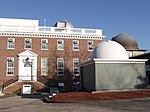Col. Thomas Wentworth Higginson House
Cambridge, Massachusetts Registered Historic Place stubsHouses completed in 1880Houses on the National Register of Historic Places in Cambridge, MassachusettsQueen Anne architecture in Massachusetts

The Col. Thomas Wentworth Higginson House is a historic house in Cambridge, Massachusetts. It is named after author, minister, and abolitionist Thomas Wentworth Higginson, who had it built and lived there for a time.The house was built in 1880 and added to the National Register of Historic Places in 1982. It was the first home that Higginson ever owned. As he wrote to his sister shortly after moving in, "It is such inexpressible happiness to have at last a permanent home."
Excerpt from the Wikipedia article Col. Thomas Wentworth Higginson House (License: CC BY-SA 3.0, Authors, Images).Col. Thomas Wentworth Higginson House
Sparks Street, Cambridge
Geographical coordinates (GPS) Address Nearby Places Show on map
Geographical coordinates (GPS)
| Latitude | Longitude |
|---|---|
| N 42.380277777778 ° | E -71.130555555556 ° |
Address
Sparks Street 74
02163 Cambridge
Massachusetts, United States
Open on Google Maps










